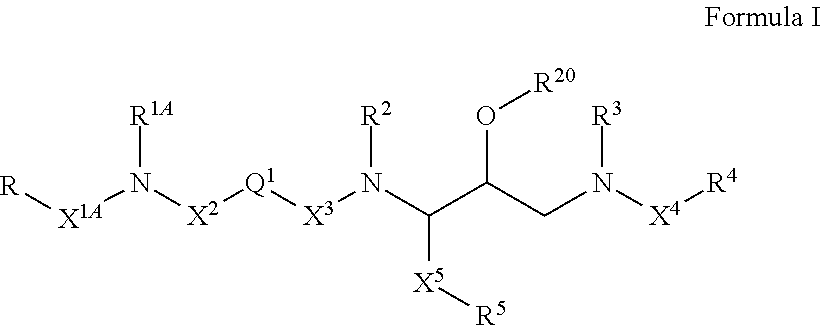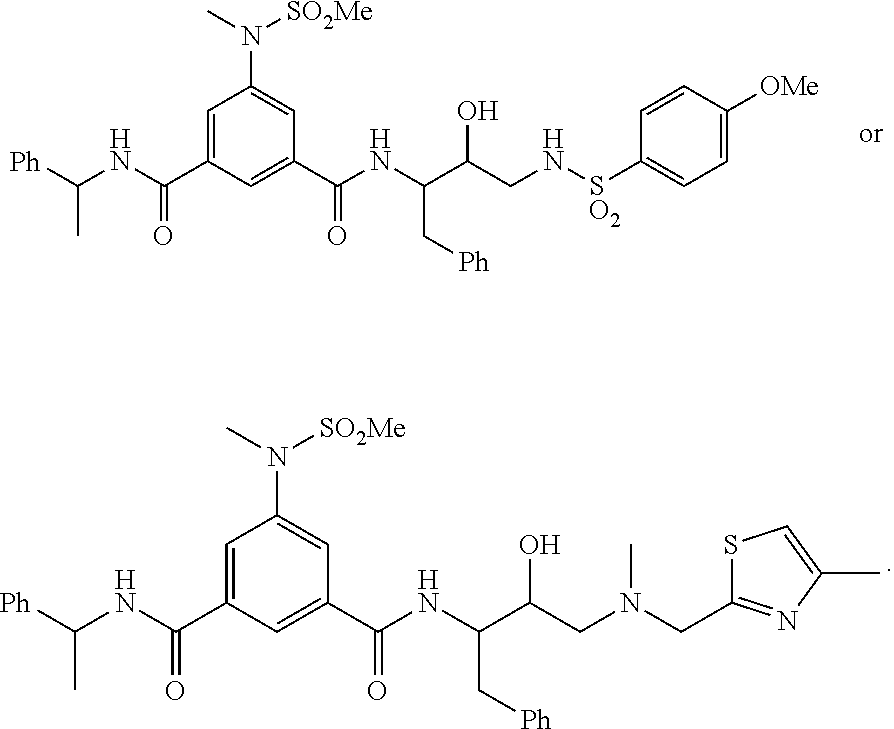Nonpeptide hiv-1 protease inhibitors
a technology of protease enzyme and non-peptide, which is applied in the direction of biocide, heterocyclic compound active ingredients, amide active ingredients, etc., can solve the problems of increasing the toxicity reducing the complexity of these treatment regimens, and eradicating human immunodeficiency virus type 1 (hiv 1) appears to be currently unachievable, so as to improve the quality of life, enhance the management of hiv, and stop the progression
- Summary
- Abstract
- Description
- Claims
- Application Information
AI Technical Summary
Benefits of technology
Problems solved by technology
Method used
Image
Examples
example 1
Synthesis
[0236]The compounds herein contemplated are synthesized by an appropriate combination of generally well known synthetic methods. Techniques useful in synthesizing the compounds described herein are both readily apparent and accessible to those of skill in the relevant art. The discussion below is offered to illustrate certain of the diverse methods available for use in assembling the compounds described herein. However, the discussion is not intended to define the scope of reactions or reaction sequences that are useful in preparing the compounds described herein.
[0237]In an illustrative example, inhibitors described herein are synthesized using the route shown in the following scheme. Other examples can be prepared using routine modifications, known to those skilled in the art of organic synthesis, of the schemes shown herein.
[0238]In another embodiment, compounds of formula I, wherein X2 and X3 are —C(O)— and R20 is hydrogen are synthesized as shown below.
[0239]In another...
example 2
Inhibition of HIV Proteases
[0242]Without being bound by theory, it is suggested that the compounds described herein may exert their utility by the inhibition of proteases encoded by human immunodeficiency virus. Techniques for measurement of the ability of the compounds herein described to decrease the proteolytic activity of proteases encoded by HIV are well known to those skilled in the relevant art and any one or combination of such techniques can be used to measure the inhibition of protease activity of the compound herein described. One illustrative method is described by Toth and Marshall (Toth & Marshall, Int. J. Pep. Protein Res. (1990), 36, 544-550). The disclosure of the foregoing is incorporated herein in its entirety by reference. In addition, the entirety of the disclosures of each of the publications cited herein are also incorporated herein by reference. Measured inhibition constants are shown in TABLE 1.
TABLE 1InhibitionInhibition ofof HIV-1CompoundHIV-1 (Ki)(IC50) ...
PUM
| Property | Measurement | Unit |
|---|---|---|
| pharmaceutical composition | aaaaa | aaaaa |
| pharmaceutical compositions | aaaaa | aaaaa |
Abstract
Description
Claims
Application Information
 Login to View More
Login to View More - R&D
- Intellectual Property
- Life Sciences
- Materials
- Tech Scout
- Unparalleled Data Quality
- Higher Quality Content
- 60% Fewer Hallucinations
Browse by: Latest US Patents, China's latest patents, Technical Efficacy Thesaurus, Application Domain, Technology Topic, Popular Technical Reports.
© 2025 PatSnap. All rights reserved.Legal|Privacy policy|Modern Slavery Act Transparency Statement|Sitemap|About US| Contact US: help@patsnap.com



